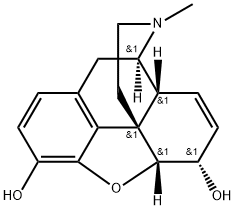
모르핀
한글명:모르핀
카스 번호57-27-2
상품명:MORPHINE
CBNumberCB0680482
분자식C17H19NO3
포뮬러 무게285.34
MOL 파일57-27-2.mol
동의어(한글)
모르핀
화학적 성질
| 녹는점 | 255°C |
| 끓는 점 | 427.77°C (rough estimate) |
| 밀도 | 1.0864 (rough estimate) |
| 굴절률 | 1.5400 (estimate) |
| 인화점 | 11 °C |
| 저장 조건 | −20°C |
| 용해도 | 에탄올(약간), 메탄올(약간)에 용해됨 |
| 물리적 상태 | 고체 |
| 물리적 상태 | 단단한 모양 |
| 산도 계수 (pKa) | 8.21(at 25℃) |
| 색상 | 흰색에서 연한 노란색 |
| 수용성 | 0.4mg/L(25℃) |
| BCS Class | 1,3 |
| CAS 데이터베이스 | 57-27-2 |
| EPA | Morphinan-3,6-diol, 7,8-didehydro-4,5-epoxy-17-methyl- (5.alpha.,6.alpha.)- (57-27-2) |
| 위험품 표기 | F,T | |||||||||
| 위험 카페고리 넘버 | 11-23/24/25-39/23/24/25 | |||||||||
| 안전지침서 | 7-16-36/37-45 | |||||||||
| 유엔번호(UN No.) | UN 1230 3/PG 2 | |||||||||
| WGK 독일 | 2 | |||||||||
| 유해 물질 데이터 | 57-27-2(Hazardous Substances Data) | |||||||||
| 독성 | An alkaloid of the opium poppy that makes up between 9% and 14% of good grades of opium. Morphine is usually used clinically as an analgesic in the form of the sulfate or hydrochloride salt. The most important acute toxic effect of large doses of morphine is depression of the respiratory centers in the medulla and pons. Morphine and related drugs also cause somnolence, coma, cold clammy skin, bradycardia, and hypotension. Initial doses of morphine seem to stimulate the chemoreceptor trigger zone to induce emesis, with subsequent doses blocking the vomiting center, hence blocking emesis. Morphine also has profound effects on the gastrointestinal tract, increasing the tone of the intestinal tract, but decreasing the propulsive or spasmodic reflexes, thus resulting in constipation. Morphine stimulates the nucleus of the third cranial nerve to produce miosis, making pinpoint pupil a diagnostic sign both in morphine overdose and morphine addiction. Morphine causes a variety of effects on the CNS and is highly addictive. Many behavioral changes are seen, ranging from euphoria to sedation. These behavioral effects contribute to the problem of abuse with all of the opiates. Tolerance and dependence occur with repeated dosing, with increasingly larger doses being needed to obtain the original effect. Abrupt withdrawal after chronic use can lead to physiological rebound in these same systems. Therapy for acute overdosage involves physiological support (establishment of adequate respiratory exchange), gastric lavage, and use of narcotic antagonists. Morphine and related compounds act by binding to specific high-affinity receptors concentrated in the nervous system, but also located elsewhere in the body. In the nervous system, the endogenous ligands for these morphine receptors are the opioid peptides that include the enkephalins, endorphins, and dynorphins. The multiple and complex actions of morphine are due, in part, to the fact that it acts as an agonist at many of these classes of receptors. Paregoric (camphorated tincture of opium) is used as an antidiarrheal. Paregoric is a schedule III drug under the US Controlled Substances Act and may produce physical dependence. | |||||||||
| NFPA 704: |
|


